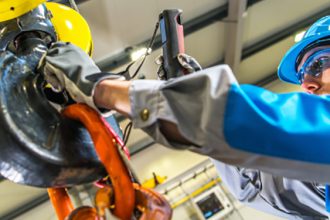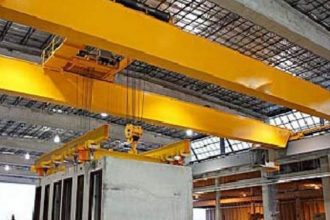How The Internet Of Things Benefits Overhead Crane Owners And Operators

Every supply chain, distribution, and manufacturing operation wants to save time and reduce costs, including those that rely on one or more overhead crane system within their facilities. With the latest developments in technologies that leverage the Internet of Things (IoT), remote monitoring and analysis of overhead equipment, its operation, and its components, it’s becoming easier for system owners and operators to do just that.
The IoT connects the Internet to the sensors and devices embedded throughout industrial equipment and machinery through a local network. Data about crane status and performance is transmitted wirelessly via cloud computing to system owners and managers, as well as to the original equipment manufacturer (OEM), for analysis in real-time.
IoT solutions are currently in use by only 21% of material handling equipment owners, found the recently released 2022 MHI Annual Industry Report. However, those same supply chain leaders say IoT will be adopted by 80% of them by 2027. The reason? According to 45% of survey respondents, IoT technology has the potential to disrupt the industry in a positive way, or to create a competitive advantage for those who use it. Further, 39% note that IoT supports ongoing operational improvements. Armed with information gleaned directly from the equipment as it is in use makes it possible to gain a clearer, more accurate, and instantaneous understanding of the equipment’s operation — yielding both time and cost savings.
Collectable datasets include travel, lift and lower speeds, limit states, vibration, temperature, amperage ranges, drive faults, the magnitude of the load, duration of travel, contactor switch functions, total operating hours for individual motions. As the data has been documented, it can be continuously compared to historic data for identification of trends and more accurate timing of predictive and preventive maintenance based on actual usage rather than estimated wear. Further, with IoT connectivity, managers and owners can be alerted to unsafe conditions as they occur, while event-based notifications can be sent to key personnel via text or email when a pre-determined threshold is reached.
While it’s true that most of this data has been available for a long time, what’s new is the ability to access it remotely via the Internet. Until now, only an authorized technician could retrieve such data by physically connecting a laptop or tablet to the crane for a batch download. With an IoT-enabled crane, however, the information is instantly accessible, typically via a secure, web-based dashboard or an app. Further, as the technologies that enable IoT connectivity for overhead handling equipment become more affordable and available, more crane OEMs — including several members of the Crane Manufacturers Association of America (CMAA) — are offering it as a solution on new systems or as a retrofit on existing installations.
Not only does IoT-collected data from overhead equipment benefit system owners, but it also allows OEMs to aggregate and analyze data about multiple crane installations at different customer facilities. This helps manufacturers identify common wear patterns and assess root causes. It also allows for software and firmware updates to occur as soon as the new upgrade is available for programmable logic controllers (PLCs), variable frequency drives (VFDs), or electric (EC) motors, rather than waiting for an on-site visit from a technician.
Looking for more details on the latest developments in crane and overhead handling technology? The members of the Crane Manufacturers Association of America (CMAA) represent the industry’s leading suppliers of overhead crane systems. They design, manufacture, assemble, install and service overhead cranes and components. CMAA members, with the combined experience of more than 30,000 crane installations in North America in the last decade, are committed to providing products which focus on safety and innovation. The organization offers a variety of resources — including buyers’ guides, engineering specifications, OSHA Alliance safety tip and fact sheets, inspection and maintenance checklists, safety seminars and more — via its website at www.MHI.org/CMAA.



